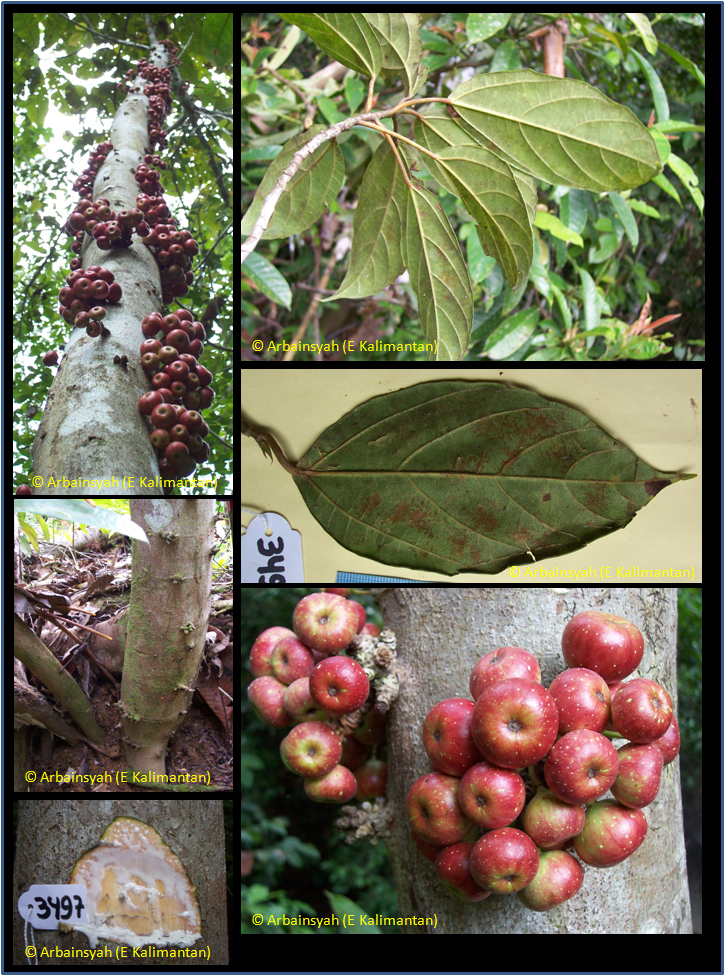Ficus racemosa L., Sp. Pl. 1060 (1753)
Species name meaning 'raceme-like', referring to the inflorescences.Synonyms
Covellia glomerata (Roxb.) Miq.
Ficus acidula King
Ficus chittagonga Miq.
Ficus glomerata Roxb.
Ficus glomerata var. chittagonga (Miq.) King
Ficus glomerata var. elongata King
Ficus glomerata var. miquelii King
Ficus glomerata var. mollis (Miq.) King
Ficus henrici King
Ficus lanceolata Buch.-Ham. ex Roxb.
Ficus leucocarpa (Miq.) Miq.
Ficus lucescens Blume
Ficus mollis (Miq.) Miq. [Illegitimate]
Ficus racemosa var. elongata (King) M.F.Barrett
Ficus racemosa var. miquelii (King) Corner
Ficus racemosa var. mollis (Miq.) M.F.Barrett
Ficus racemosa var. racemosa
Ficus racemosa var. vesca (F.Muell. ex Miq.) M.F.Barrett
Ficus semicostata F.M.Bailey
Ficus trichocarpa forma glabrescens Engl.
Ficus vesca F.Muell. ex Miq.
Diagnostics
Deciduous (in drier areas) cauliflorous tree, 20-30 m tall, buttressed, often with irregular
crown. Stipules up to 4 cm long, glabrous, often persistent. Leaves alternate, glabrous, clearly
tri-veined, venation pronounced. Infructescences in big clusters on branching, leafless twigs
on stem and larger branches. Fruit a fig, pyriform to subglobose, 2.5-5 cm in diameter,
rose-red when ripe.
Description
Monoecious tree, up to 20-30 m tall, 25 cm diameter. Bark greenish white, smooth; inner
bark yellowish. Sapwood whitish. Twigs slender, reddish brown, c. 0.2 cm thick, Stipules
narrowly lanceolate, up to 4 cm long, glabrous, often persistent. Leaves distichous,
membranous, glabrous, pale glaucous below; oblong, 5-11 x 1.5-3.5 cm, base broadly
cuneate, margin entire, plane, faintly undulate, apex obtuse; midrib raised above; lateral
veins 10-15 pairs, curved, very faint on both surfaces, with shorter veins in between,
basal pair short, often with a gland in each axil below; intercostal venation reticulate,
faint; petiole slender, 1-4 cm long. Syconia borne on long leafless branched twigs arising
from stem and older branches, ripening red, pear-shaped, 1-1.5 cm diameter, apex
depressed; peduncle 0.3-1.2 cm long; basal bracts ovate, triangular, 1-2 mm long; internal
bristles absent. Tepals 3-4, red, glabrous, united at the base. Achenes lenticular, c. 1
mm long, smooth, not or scarcely keeled. [from Tree Flora of Sabah and Sarawak]
Ecology
In open lowland deciduous forest, common along river banks.
Uses
The figs, which are rather insipid but sweet, are edible. They are used in various preserves
and side-dishes. Leaves are eaten as vegetable and are said to be used against diarrhoea.
They are also used as animal fodder and they provide a valuable mulch. In India the tree is
also cultivated as host plant for lac insects, shade tree for coffee and a rootstock for Ficus
carica L. The latex is used in production of water-resistant paper and as plasticizer for
Hevea rubber. In the Atharva Veda, this fig tree is given prominence as a means for acquiring
prosperity and vanquishing foes. The bark of Audumbar/Oudumbar tree is said to have healing power.
In countries like India, the bark is rubbed on a stone with water to make a paste and the paste
is applied over the skin which is afflicted by boils or mosquito bites. Allow the paste to dry
on the skin and reapply after a few hours. For people whose skin is especially sensitive to
insect bites; this is a very simple home remedy.
Distribution
North-eastern Africa, India to Indo-China, Malesia to northern and western Australia.
Not in the Philippines. In India also cultivated.
Local names
Burma: atti, umbar.
Cambodia: lovi?.
English: Cluster fig, red river fig.
India: gular (North), atti (South), udumbara (Sanskrit).
Indonesia: elo (Javanese), loa (Sundanese), arah (Madurese).
Laos: dua kiengz.
Singapore: atteeka.
Thailand: duea kliang (central, northern), duca nam (peninsular).
Vietnam: sung.
